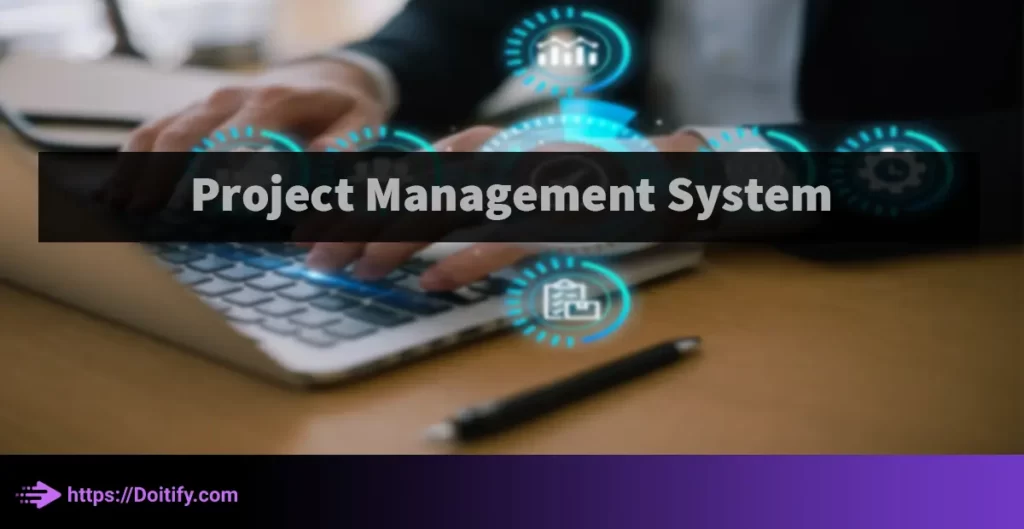Are you struggling to keep your projects on track, meet deadlines, and ensure effective collaboration among team members? Look no further! A project management system is the solution you need to streamline your project workflows and achieve optimal project outcomes. In this article, we will explore the world of project management systems definition, and why they are vital in today’s business environment.
In a fast-paced and competitive business landscape, managing projects efficiently is paramount for success. According to a recent study, organizations that implement project management systems experience a 20% increase in project success rates and a 15% improvement in team productivity. Effective project management is essential for organizations to deliver projects on time, within budget, and with the desired quality. A project management system provides the necessary tools, features, and functionalities to streamline project workflows, improve collaboration, and maximize project success.
This article will provide you with a comprehensive understanding of project management system definition, their benefits, and how they can revolutionize the way you manage projects. By the end of this article, you will have a clear understanding of what a project management system is, how it can benefit your organization, and the key features to look for when choosing the right system.
Table of Contents

Project Management System Definition
Project management system definition is that it’s a software tool designed to assist organizations in planning, organizing, and executing projects efficiently. It provides a centralized platform where project managers and teams can collaborate, track progress, manage resources, and monitor project milestones. A project management system typically includes features such as task management, scheduling, document sharing, communication tools, and reporting capabilities.
When selecting a project management system, it is important to consider the specific needs of your organization. Different systems offer varying levels of complexity and functionality, so it’s crucial to choose one that aligns with your project requirements and team dynamics.
We have been written about Project Management Software in another article.
Key Features Of A Project Management System
A project management system encompasses a range of essential features that enable efficient project planning, execution, and monitoring.
Here are the key features that make a project management system indispensable:
Centralized Project Documentation And Collaboration
A project management system provides a centralized platform where project documentation and files can be stored, accessed, and shared by team members. This feature eliminates the need for scattered documents across multiple platforms or email threads, ensuring seamless collaboration and easy information retrieval. By having a central repository, team members can work on the most up-to-date project documents, fostering productivity and reducing the risk of errors caused by outdated information.
Task And Milestone Tracking
Efficient task and milestone tracking are vital components of project management. As project management system definition explain, it’s allows project managers to assign tasks to team members, set deadlines, and track progress in real-time. This feature enables better project visibility, ensuring that tasks are completed on time and milestones are achieved as planned. Project managers can also monitor task dependencies, identify bottlenecks, and make necessary adjustments to keep the project on track.
Resource Allocation And Management
Resource allocation and management are critical aspects of project planning and execution. A project management system enables project managers to allocate resources such as human capital, equipment, and materials effectively. By having a clear overview of resource availability and utilization, project managers can optimize resource allocation, avoid overbooking, and ensure that the right resources are allocated to the right tasks. This feature enhances project efficiency and minimizes resource wastage.
Reporting And Analytics
Accurate and timely reporting is essential for project stakeholders to monitor project progress, make informed decisions, and identify areas that require attention. A project management system offers robust reporting and analytics capabilities, generating comprehensive reports, charts, and dashboards that provide insights into project performance. Project managers can track key performance indicators, identify trends, and make data-driven decisions to improve project outcomes. This feature enhances project transparency and enables stakeholders to have a holistic view of the project’s status.
Integration With Other Business Tools
To streamline project workflows and enhance productivity, a project management system should seamlessly integrate with other business tools commonly used within the organization. Integration with tools such as communication platforms, document management systems, and time tracking software eliminates the need for manual data entry and promotes data consistency across different applications. This feature enables a more streamlined and efficient project management process, reducing administrative overhead and enhancing collaboration.
We have been written about Free Project Management Tools in another article.
Benefits Of Using A Project Management System
Implementing a project management system definition in a project management tool yields numerous advantages that empower organizations to effectively manage their projects.
Here are the key benefits that organizations can derive from using a project management system:
Improved Project Planning And Organization
A project management system provides a structured framework that facilitates efficient project planning and organization. By centralizing project-related information, such as goals, tasks, timelines, and dependencies, organizations can develop comprehensive project plans with clear objectives and defined milestones. This systematic approach enables project managers to prioritize tasks, allocate resources effectively, and mitigate potential risks. As a result, organizations can enhance their project planning capabilities, leading to better project outcomes and increased overall efficiency.
Enhanced Team Collaboration And Communication
Effective collaboration and communication are vital for project success. A project management system serves as a collaborative platform where team members can easily share project-related information, discuss tasks, and provide updates in real-time. This feature fosters seamless communication among team members, regardless of their geographical locations. By enabling transparent and efficient communication, a project management system promotes synergy, minimizes miscommunication, and enhances teamwork, leading to improved project collaboration and increased productivity.
Efficient Task Management And Tracking
Task management is a fundamental aspect of project execution. A project management system provides features that enable organizations to efficiently manage and track tasks throughout the project lifecycle. Project managers can assign tasks, set deadlines, and track progress in real-time. This visibility ensures that tasks are completed on time, bottlenecks are identified promptly, and adjustments can be made as necessary. By facilitating efficient task management and tracking, a project management system enhances project efficiency, reduces delays, and improves overall project performance.
Real-Time Visibility Into Project Progress
One of the significant advantages of a project management system is the ability to gain real-time visibility into project progress. Through intuitive dashboards and reporting features, project managers and stakeholders can access up-to-date information on project status, milestones achieved, and potential roadblocks. Real-time visibility empowers project managers to make informed decisions, proactively address issues, and ensure projects stay on track. By having a comprehensive view of project progress, organizations can improve project transparency, identify areas for improvement, and effectively manage project timelines and resources.
Streamlined Resource Allocation And Utilization
Efficient resource allocation and utilization are critical for project success. A project management system provides organizations with a clear overview of available resources, their allocations, and utilization rates. With this information at hand, project managers can make data-driven decisions regarding resource allocation, ensuring that resources are optimally distributed based on project requirements. By streamlining resource allocation and utilization, organizations can maximize resource efficiency, avoid resource bottlenecks, and effectively allocate resources to tasks, resulting in improved project performance and increased productivity.
We have been written about Project Management Software Benefits in another article.
Choosing The Right Project Management System
To ensure effective project management, organizations must carefully choose a project management system that meets their specific needs.
Here are five key considerations when selecting a project management system:
Assessing Organizational Needs And Requirements
Before diving into the selection process, it’s crucial to assess your organization’s needs and requirements. Consider factors such as project size, complexity, team size, and collaboration needs. Identify the specific features and functionalities that your projects demand. For example, if your projects require Gantt charts for visualizing timelines and dependencies, prioritize systems that offer robust Gantt chart capabilities. By understanding your organization’s unique needs, you can narrow down the options and select a system that aligns with your project management goals.
Evaluating Key Features And Functionalities
Once you have identified your organizational needs, evaluate the key features and functionalities offered by different project management systems. Look for features such as task management, resource allocation, time tracking, reporting, and collaboration tools. Consider whether the system supports your preferred project management methodology, be it traditional, agile, or hybrid. Additionally, integration capabilities with other tools and platforms, such as document sharing or communication tools, can improve efficiency and streamline workflows. By thoroughly evaluating the available features, you can prioritize the systems that offer the most relevant functionalities for your projects.
Considering Scalability And Flexibility
As organizations grow and undertake larger projects, scalability becomes a crucial factor. Consider the scalability of the project management system you choose. Can it accommodate an increasing number of projects, users, and data without compromising performance? Additionally, assess the system’s flexibility to adapt to changing project requirements and methodologies. A flexible system allows you to customize workflows, add or modify project stages, and incorporate new features as your needs evolve. By choosing a scalable and flexible project management system, you can ensure that it continues to meet your organization’s requirements as you grow.
Examining User Interface And User Experience
The user interface and user experience of a project management system play a significant role in its adoption and usability. A system with an intuitive and user-friendly interface can enhance productivity and reduce the learning curve for team members. Look for systems that offer a clean and organized interface, easy navigation, and clear task and project visualization. Additionally, consider the availability of mobile apps or responsive web interfaces, as they enable team members to access and update project information on the go. By prioritizing a system with a positive user experience, you can ensure higher user engagement and smoother project execution.
Reviewing Pricing And Support Options
Finally, evaluate the pricing models and support options offered by project management system providers. Consider whether they offer subscription-based pricing, one-time licensing fees, or freemium models, and assess which option aligns with your budget and cost expectations. Additionally, review the level of customer support provided, including technical assistance, training resources, and community forums. Robust customer support is essential for resolving issues, addressing concerns, and maximizing the value derived from the project management system.

We have been written about Project Management Tool With Gantt Chart in another article.
Best Practices For Using A Project Management System
To maximize the benefits of a project management system, it is crucial to follow best practices that optimize its usage. This article presents a comprehensive guide on the best practices for using a project management system effectively, including defining clear project goals, establishing effective communication channels, setting up a standardized project structure, regularly updating project documentation, and encouraging collaboration and accountability.
Defining Clear Project Goals And Objectives
One of the fundamental best practices for using a project management system is to define clear project goals and objectives from the outset. Before initiating any project, take the time to identify and document the desired outcomes, deliverables, and success criteria. These defined goals will serve as a guiding force throughout the project lifecycle, ensuring that all team members are aligned and working towards a common purpose. By inputting and tracking these goals within the project management system, it becomes easier to monitor progress, measure success, and make informed decisions.
Establishing Effective Communication Channels
Effective communication is the cornerstone of successful project management. To leverage the full potential of a project management system, establish clear and efficient communication channels. Depending on the organization’s needs, this may involve utilizing built-in communication features within the system, integrating with external communication tools, or a combination of both. Encourage team members to communicate regularly, share updates, seek clarification, and address any challenges or roadblocks. By centralizing communication within the project management system, all stakeholders have easy access to important project-related information, fostering transparency and collaboration.
Setting Up A Standardized Project Structure
Consistency and structure are vital when using a project management system. Establishing a standardized project structure ensures that projects are organized in a uniform manner, making it easier to navigate and locate specific information. Define a consistent naming convention for tasks, milestones, and project phases. Categorize tasks using relevant tags or labels to facilitate filtering and searching. By implementing a standardized project structure, team members can quickly understand project components, dependencies, and progress, leading to improved efficiency and clarity.
Regularly Updating And Maintaining Project Documentation
Accurate and up-to-date project documentation is crucial for effective project management. Encourage team members to consistently update and maintain project documentation within the project management system. This includes keeping task descriptions, timelines, and dependencies current. Regularly reviewing and updating project documentation ensures that all stakeholders have access to the latest information, reducing confusion and misalignment. It also provides a comprehensive historical record that can be invaluable for future reference, audits, or lessons learned.
Encouraging Collaboration And Accountability
A project management system serves as a collaborative platform, enabling teams to work together seamlessly. Encourage collaboration by leveraging the system’s features such as task assignments, shared document repositories, and discussion forums. Foster a culture of accountability by setting clear expectations, assigning responsibilities, and tracking progress within the system. Regularly monitor task statuses, provide feedback, and address any performance issues promptly. By emphasizing collaboration and accountability, project teams can drive productivity, ensure timely task completion, and deliver successful outcomes.
We have been written about Simple Project Management Tool in another article.
Conclusion
In conclusion, selecting the right project management system is a critical decision that can significantly impact your organization’s project success. By harnessing the power of a well-designed system, you can streamline workflows, enhance collaboration, and achieve optimal project outcomes. Remember to consider your organization’s specific needs, scalability, user-friendliness, integration capabilities, and security when choosing a project management system. Invest time in research and evaluation to ensure you find the perfect fit. With the right system in place, your organization can navigate the complexities of project management with ease and efficiency.
FAQs
What is a project management system, and why is it important?
A project management system is a software tool that helps streamline project workflows, enhance collaboration, and maximize project success. It provides a centralized platform for organizing tasks, resources, and project-related information. Project management systems are crucial because they enable efficient resource allocation, promote effective communication and collaboration, and provide real-time visibility into project progress.
What features should I look for when choosing a project management system?
When choosing a project management system, consider features such as task management, scheduling, document sharing, communication tools, and reporting capabilities. Customizability, scalability, user-friendliness, integration capabilities, and security are also important factors to consider.
How can a project management system improve collaboration among team members?
A project management system provides a centralized platform where team members can collaborate on tasks, share documents, and communicate effectively. It eliminates the need for scattered communication channels and facilitates real-time collaboration regardless of geographical locations. This promotes teamwork, knowledge sharing, and faster decision-making.
Can a project management system help in tracking project progress?
Yes, project management systems offer real-time visibility into project progress. They provide metrics, charts, and dashboards that allow stakeholders to monitor project milestones, track task completion, identify bottlenecks, and make data-driven decisions for timely project completion.
How can a project management system benefit my organization’s productivity?
A project management system optimizes productivity by enabling efficient resource allocation, minimizing wasted resources, and promoting effective communication and collaboration. It streamlines project workflows, ensures timely task completion, and provides a centralized platform for knowledge sharing and decision-making.
Is it necessary for a project management system to integrate with other tools used in my organization?
Integration capabilities are beneficial as they allow seamless data transfer and collaboration across different tools used within your organization. Integration with communication platforms, document management systems, or time tracking tools can enhance productivity and streamline workflows.
What should I consider in terms of security and data privacy when choosing a project management system?
Security and data privacy are crucial considerations. Ensure that the project management system follows industry-standard security protocols, offers data encryption, and has robust access controls. Protecting sensitive project data should be a priority to maintain confidentiality and prevent unauthorized access.



